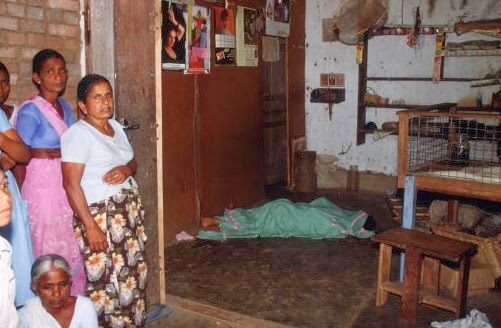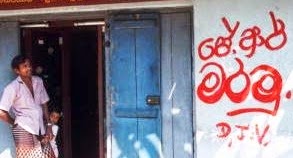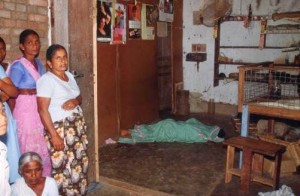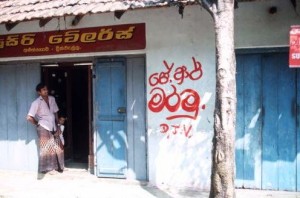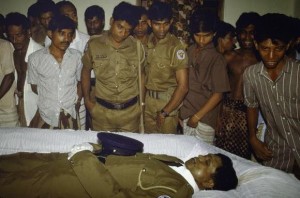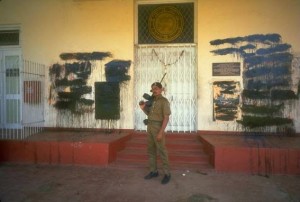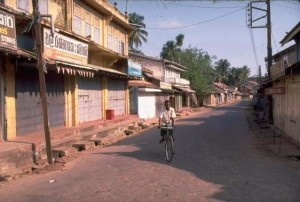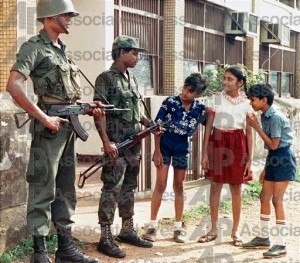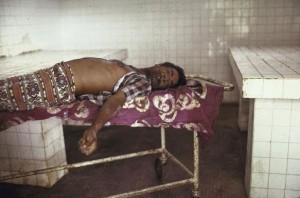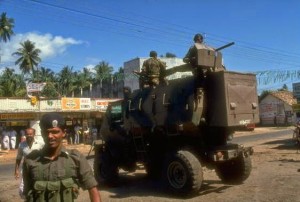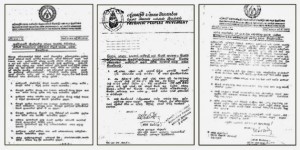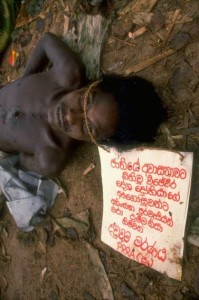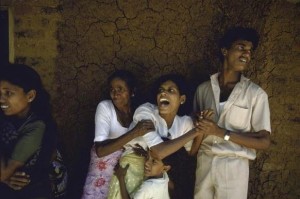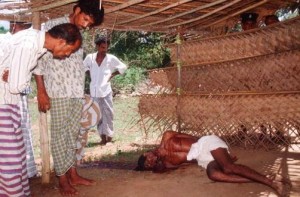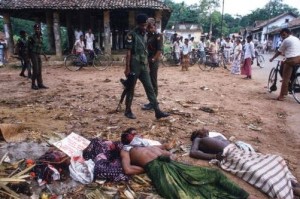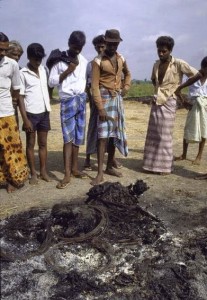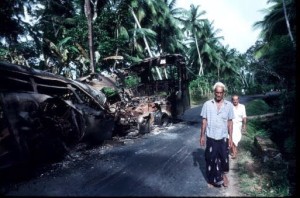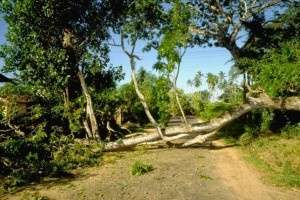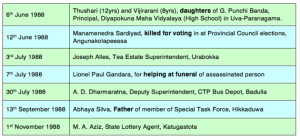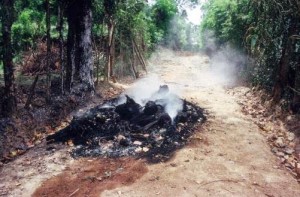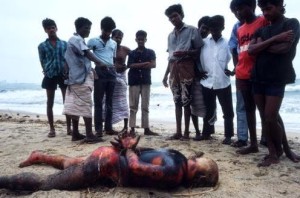The following article with images, was originally published by a blogger who blogs at thecarthaginiansolution.wordpress.com, in last year.
In late 2012, workers digging foundations for a new wing in Matale Hospital unearthed partial skeletons of more than 150 people. Of the various theories that sought to explain how this mass grave came to be, the one that most people instinctively thought might be true was that this was the final resting place of victims of death squads from 2nd JVP insurgency, which from 1987 to 1989 almost brought the Sri Lankan State to total collapse. The counter-insurgency (COIN) campaign, which in turn destroyed the JVP had few equals (except perhaps the 1990s Algerian counter-insurgency campaign and the India’s anti-’Khalistan’ counter-insurgency in the Punjab) for its ruthlessness.
Unlike today’s COIN warriors who use seemingly benign terms like “Fight, Secure, Build”, Sri Lanka’s COIN warriors used the more honest, “Search, Interrogate and Destroy” to characterise their brutal, blood-stained and ultimately successful campaign to crush the JVP.
Family members mourn the loss of a loved one who was killed by JVP. April 1989.
(Photo by Robert Nickelsberg/Liaison)
The US State Dept neatly summarised the background to the 1987-1989 JVP insurgency.
“In 1989 the JVP stepped up its campaign against the Government and population at large. Likened by some observers to Pol Pot’s Khmer Rouge and the Maoist Shining Path in Peru, the JVP sought to topple Sri Lanka’s elected Government through a campaign of murder, intimidation, and strikes designed to paralyse civil administration, cripple the economy, and disrupt society. It did so despite repeated efforts by the Sri Lankan Government to bring the JVP into the political mainstream. In 1988 the Government had legalized the JVP and invited it to participate in the elections.
“Let us kill JR” – anti-govt graffiti by DJV (military arm of the JVP) urging death to President JR Jayawardene, displayed in front of a post office. December 1989. (Photo by Robert Nickelsberg/Liaison)
The JVP responded by killing voters and candidates in an attempt to disrupt elections held in late 1988 and early 1989. In January 1989, in an effort to open a dialog with the JVP, newly elected President Ranasinghe Premadasa released 1,800 JVP suspects and lifted the state of emergency. The JVP nonetheless continued its terror campaign of targeting hospitals, transportation, and other essential services, murdering union leaders who refused to participate in JVP-called strikes and killing the families of security force personnel. At mid-year, the Government began a massive crackdown on the JVP. It detained several thousand JVP suspects. By the end of the year, security forces had captured or killed much of the JVP’s top leadership.”
A “massive crackdown” sounds quite reasonable until you realise the levels of ultra-violence used by the state to defeat the JVP.
The Years of Blood
An incomplete body count showed that from 1987-1989 the JVP murdered hundreds of members of the working class to force them to join anti-government strikes. They also murdered 1,700+ government supporters, 500+ government servants, 200+ service personnel, 350+ police personnel, 100+ home guards and 70+ politicians of all parties including many senior politicians. And over 32,000 civilians for various ‘offences’ committed against the movement.
Family gathered around open coffin mourning at funeral for policeman killed by land mine blast set off by the JVP.
April 1989 (Photo by Robert Nickelsberg//Time Life Pictures/Getty Images)
In 1989, the JVP murdered 24 members of the Buddhist clergy for refusing to bow to their demands. Their killing spree continued to include over 120 school principals, educationalists, professors, doctors, lawyers, journalists and medical staff. Even TV announcers were killed. Anyone who held any kind of leadership function in government or commerce was deemed a legitimate target by the JVP.
Armed soldier stands before the Bank of Ceylon, which is locked up tight and has crossed-out graffiti on the front.
Dec 1988 (Photo by Robert Nickelsberg//Time Life Pictures/Getty Images)
And the JVP killed hundreds of leftist politicians and activists. In September 1988, JVP ordered nationwide strikes with widespread compliance. Shops, transport, hospitals and government services were shut. Listening to radios or watching TV was prohibited with death as punishment for disobeying orders. By November 1988, Sri Lanka experienced near total anarchy. Oil refineries remained closed due to JVP instigated strikes. Public and private transport reduced to such low levels that food shortages threatened.
A lone cyclist rides on empty street in Akuressa, past shops closed due to general strike called by the JVP.
December 1988. (Photo by Robert Nickelsberg//Time Life Pictures/Getty Images)
Bank, Postal and Telecommunications virtually halted. It was a relentless, daily round of killings, sabotage and strikes organised by the JVP and of counter-terror by Security forces. The JVP’s stated aims were to seize power, overthrow the existing power structure and transform society along more equitable lines. Its first political assassination was killing a leftist student leader. The JVP really proved dictum, “Kill one man, terrorise a thousand”.
The Army Fights on Two Fronts
The Armed Forces, whilst fighting the LTTE in the Tamil-majority North also had to contend with JVP attacks in the Sinhala-majority South. For instance, Pallekelle Army camp was attacked by the JVP in April 1987 and a quantity of automatic weapons removed. The JVP also took advantage of crises in the Northern front to stage attacks in the South. A classic instance of this was the JVP attack on Katunayake Air Force base in June 1987 after the LTTE had massacred 33 novice Buddhist monks in Aaranthalawa and as the Indian Air Force air-dropped food supplies in Jaffna, against Sri Lanka’s wishes. [p.1137-9 YOT]
Children look at weapons held by soldiers on guard in Colombo. December 1989. The soldiers were deployed to prevent attacks by JVP radicals who torched 43 passenger buses in central and southern Sri Lanka. (AP Photo)
The JVP claimed that these captured arms would be used “for the freedom of the motherland.. to drive away the Indian monkeys [the Indian Peace Keeping Force – IPKF – stationed in the North] and the Tigers who have been a curse on the motherland”. As the Sinhala South soon discovered, the JVP instead, used their arms on the Security forces, their Sinhala opponents and ‘traitors’. In fact there’s not a single confirmed account of a JVP attack on the LTTE or IPKF which was trying to keep the peace in Northern Sri Lanka.
Victim killed as suspected informer by JVP, April 1989.
(Photo by Robert Nickelsberg//Time Life Pictures/Getty Images)
The JVP continued their propaganda aimed at getting soldiers to desert and join their ranks, with JVP radio repeatedly warning that August was the deadline for security forces personnel of all ranks to desert or face the consequences: death. By August 1989 on finding that their appeals had fallen on barren ground, it finally resorted to an act of such monumental folly that it echoed Tallyrand’s famous saying, “this is worse than a crime, it’s a blunder”. The JVP informed the security forces that their families would be specifically targeted for death, which provoked a wave of indignation and anger within the armed forces. An officer said “even the fellows who are sweeping the camps went out with their broomsticks against the JVP” [p.293 SL:YOT]
Heavily armed soldiers sit on top of an APC vehicle, rolling down the street. December 1988.(Photo by Robert Nickelsberg//Time Life Pictures/Getty Images)
“Twelve of Yours for One of ours!” – JVP’s Fatal Blunder
The JVP knew at once that they had made an irrevocable and fatal mistake. No sooner had they issued death threats to the families of the servicemen, posters appeared all over the country announcing, “Ape ekata thope dolahak!” (“Twelve of yours for one of ours!) The dirty war against the JVP would be even dirtier.
Death threat posters sent out by the JVP
A vigilante group called the Deshapremi Sinhala Tharuna Peramuna (Patriotic Sinhala Youth Front) under whose auspices the ‘12 for 1’ posters appeared, circulated a note to the families of JVP activists that read:
“Dear Father/Mother/Sister,
We know that your son/brother/husband is engaged in brutal murder under the pretence of patriotism. Your son/brother/husband, the so-called patriot, has cruelly taken the lives of mothers like you, of sisters, of innocent little children. In addition he has started killing the family members of the heroic Sinhalese soldiers who fought with the Tamil Tigers and sacrificed their lives, in order to protect the motherland.
“It is not amongst us, ourselves, the Sinhalese people, that your son/brother/husband has launched the conflict in the name of patriotism? Is it then right that you, the wife/mother/sister of this person who engages in human murder of children should be free to live? Is it not justified to put you to death? From this moment, you and all your family members must be ready to die. May you attain Nirvana!”
“Patriotic Sinhala Youth Front.”
‘In October 1989 after Capt T.E. Nagahawatte, the Assistant Registra of the Peradeniya University and a volunteer soldier was killed by two gunmen inside the University premises, eighteen heads were found the next day were found the next day placed neatly around the University pond. The headless corpses had been placed in various postures in the vicinity. In the rest of the country, bodies kept appearing by the dozen.’ [p. 296-7, SL:YOT]
Dead JVP suspect with note attached saying “this is the punishment for followers of JVP signed by the PRRA”, in Thihagoda. December 1988.
(Photo by Robert Nickelsberg//Time Life Pictures/Getty Images)
The State Strikes Back
The main weapons in the anti-JVP counter-insurgency were small teams equipped with small arms, unmarked vans and led by young officers and NCOs. Unlike the campaign against the LTTE, tanks, artillery, ground attack aircraft and other heavy weapons and divisional-sized manoeuvres were of no use in this dirty war. It was a hit-job, killing-at-close-range, war.
‘Detachments were established in villages throughout Sri Lanka. The troops moved light, often out in tents in mini groups, all the while. It was imperative that the maximum number of troops did spend the maximum time operating out in the field all the time. It was considered a rare occurrence for everyone to be in a base. Troops were positioned not only at snap road blocks but also undercover. Troops dominated the terrain, by frequent incursions into the jungles and to the villages, the road by road blocks, and the countryside by setting up ambushes.’ [p.331 SL:ALR]
‘When the JVP offensive escalated, the government forces, particularly the paramilitary groups such as the PRRA (Peoples Revolutionary Red Army), Shra, Black Cats, Yellow Cats, Scorpion, Eagle, etc, went on killing extra-judicially. Reverse of fear psychosis was induced – this appeared somewhat successful, but in the long run the JVP capitalised on it by recruiting members from the families of the victims.’ [p.295 SL: ALR]
‘Under the provisions of the state of Emergency, Sri Lankan security forces were given ‘almost unlimited powers to combat the JVP, including shooting suspects on sight and disposing of bodies without an inquest. Under the Indemnity Act of December 1998, [passed before the Presidential elections in the same month] security personnel have been granted immunity from prosecution for any such abuses committed.’ [p. 144, TSCSL]
Fighting Unconventionally – ‘Search, Interrogate, Destroy’
‘There were a considerable percentage of suspects dying under interrogation and many were executed too. In most (Army) camps if a suspect was positively identified as a JVP activists, [sic] he or she had no returns. If the arrest of these suspects were recorded the circumstances under which death occurred was recorded as “killed in action” (KIA).
Terrified women and children after Army took their husbands for interrogation after land mine blasts set by JVP. April 1989. (Photo by Robert Nickelsberg//Time Life Pictures/Getty Images)
However most of those taken into custody particularly those arrested on information given by activists in custody were not recorded. Often bodies of those killed were either dumped in a river, buried in the jungle and burnt in a tyre… to ensure rapid burning, a body was dismembered and burnt.’
‘To prevent identification some were left hacked, often with their faces mutilated or decapitated. After a while troops became accustomed to carrying out this kind of operation. They often used prisoners awaiting execution to do the disfiguring or beheading at the point of a gun. In some cases special units were formed particularly in the police with men who had lost a family member, a relative or a friend at the hands of the JVP. Such men had no “hang up of executing a man or a woman who had killed their loved ones’.
Villagers looking at a victim killed by unknown groups. April 1989
(Photo by Robert Nickelsberg/Liaison)
‘Often to avoid legal implications the army and police worked in close co-operation. Sometimes a security forces team would bring a group of “sentenced” JVP activists to a point where the JVP had either burnt a bus or a post office. They would approach the site at night. If there are any houses with lights on, they would order those occupants to switch off their lights. Then they would throw the blind folded gagged men out of their vehicles and open fire on them. The team would inform the police the location of the execution either before or after the incident. By 6.00 a.m. the bodies would be brought to the police mortuary for cremation or burial. Police did not allow such bodies to be given back to the relatives. They were promptly disposed. Newspapers and even politicians called these hit squads “the vigilantes”.
‘Often these squads, also known as “death or killer squads” travelled at night – often in vehicles that had bogus number plates or not have a number plate. They carried a different assortment of weapons to prevent their true identification. They wore black overalls and were often masked, or wore beards. Undoubtedly this was the most successful way of combating the JVP. No doubt this was illegal. These hit teams were professional in their approach and rarely left any tracks. Often they were left with no alternative but to eliminate those taken into custody. Even if they proved innocent it was difficult to release an individual as the identity of the officers and men who arrested and interrogated them would be known at least by face. In the light of the threat to the families of the Forces personnel they had to cover their tracks.’
Bodies of JVP followers killed by the PRRA lie on the ground with posters tied around their necks in Tihagoda. The sign says, ”This is the punishment for followers of the JVP signed by the PRRA.”
December 1989 (Photo by Robert Nickelsberg/Liaison)
‘Troops learnt by trial and error. The moment an arrest was made the suspect was blind folded. This prevented the suspect from identifying his or her captor and became disoriented. This helped a good interrogator. The not so professional teams were death squads operated by politicians. These teams were initially formed to protect the politician but when the JVP threat could not be effectively thwarted by the police and the army, they began to operate killing their opponents. Not only did JVP activists die in this process but also supporters of the SLFP, USA and even UNP supporters over personal feuds. The answer to human survival became a method of political survival. These were some of the implications of relaxing the law in times of fighting an unconventional war.’ [p. 332 – 333, SL:ALR]
Body of victim killed by the JVP, burnt in a tyre to prevent identification.
April 1989. (Photo by Robert Nickelsberg//Time Life Pictures/Getty Images)
“From August 1989 onwards, reprisal killings against the JVP became a common feature. On any given day there were around 20 to 50 bodies found dumped on the roadsides. Some of the most spectacular killings were reported from Kandy. In the Menikhinna-Kundasale area, almost an entire village was wiped out when 200 bodies were found after the families of three servicemen (sixteen people in all) had been hacked to death by the JVP.” [p. 296-97, SL:YOT]
A Society Caught Between Two Forces
This testimony given to a committee on disappearances describes the unbearable pressures faced by ordinary people who were caught in the middle between JVP and State violence.
‘Many witnesses said that, caught between two forces as they were, their life during this period was like a “nut in a nut-cracker” (girayatha ahu vechcha puwak gediyak vagei). They felt that there existed a kind of “dual-power” situation in the country. The state had lost its hegemony, and same referred to the authority of the JVP as Punchi Aanduwa (small government). The JVP imposed its own curfews, organized island-wide hartals, and called for frequent strikes. Some joined these protest movements under JVP threats.’
An man walks past buses destroyed by the JVP near Yariyama, August 1989.
(Photo by Robert Nickelsberg/Liaison)
“The people who get the worst of this are the villagers. It’s such a small island. There’s no place to run, no place to go and make your family safe.”
A senior Western diplomat. August 1989
‘Many witnesses said that their families suffered at the hands of both the security forces and the JVP during this period. “In our area a group of JVP supporters went from house to house and asked people to assemble for a meeting. Later the Army had raided the place and arrested people. My son was among those who were arrested, and he never came back home.”
“As a punishment for supporting the SLFP in the 1988 election. The JVP asked me to kneel down on the road for three hours. However, it was the security forces who abducted my brother on a later occasion.”
‘The resultant sense of isolation was portrayed time and again in the evidence: “There was no one to complain to. The government was deaf; the opposition absent; the Police drove us away like dogs. The JVP killed, the Army killed,” said a mother who had lost three sons taken away in three different rounding-up operations never to return.’
Felled trees blocking a road – the JVP attempting to foil Presidential election voting in Southern Sri Lanka. December 1988. (Photo by Robert Nickelsberg//Time Life Pictures/Getty Images)
‘The Police and Armed Forces are not alien institutions to this society. The affected families also had their own children and relatives serving in the Police and Armed forces. We came across several instances where one member of the family was killed by subversives as a punishment for serving in the police or in the army; another member of the same family was abducted by security forces for alleged subversive activities.’
A Snapshot of Killings
The pages of International Alert’s 1989 publication “Political Killings in Southern Sri Lanka” lists a grim and incomplete memorial to those who were killed during this insurgency. A random selection of the victims’ names and places shows how no part of society was left untouched by JVP violence and the COIN campaign that ultimately destroyed it.
A small sample of political killings in Sri Lanka in 1988, taken from “Political Killings in Southern Sri Lanka”, International Alert, London 1989
A tiny sample of political killings in Sri Lanka in 1988, taken from “Political Killings in Southern Sri Lanka”, International Alert, London 1989
A Policeman’s Family Burnt Alive …
‘ In Uluvitake, on July 24, 1988, militants threw bombs and set fire to the residence of the Deputy Inspector General of Police, Premadasa Udugampola. Udugampola’s mother, brother, sister-in-law, two children were killed and burnt. Subsequently, the Udugampola brothers – a DIG, another an Inspector, and an army Major vied with each other in heading the anti-JVP war with their own special teams. Udugampola who was very active in anti-JVP operations transformed the strategy of combating the JVP from cordon off and search, to search, interrogate and destroy. It was he together with Brigadier Lakshman Algama who first started to fight JVP unconventionally.’ p.85 [SL-ALR]
… And an ‘Avenging Killer Squad’ is Born
“In areas he (DIG Udugampola) commanded, small groups of hand-picked men armed with automatic in unmarked vehicles roamed the towns and villages. The three squads of fifteen men were recruited from families that had suffered at the hands of the JVP. Therefore, they were highly motivated to hunt and kill their enemy to avenge the death of their loved ones.
The creation of this formidable force frightened the JVP. This was a force which operated both within and outside the framework of democracy, and a powerful figure of the ability and motivation of Udugampola behind them. This time the JVP was taken by surprise – they never anticipated that the state and the state-sponsored forces will ever copy and adopt their operational methods and unconventional tactics in combating them… In time, Udugampola moved from the Southern to the North Central and then to the Central Province, introducing this strategy to those were left to command. At a time when everybody predicted that the JVP has come to stay, DIG Premadasa Udugampola predicted that they will be doomed by the end of 1989.
The first question Wijeweera asked the Ops Combine team which apprehended him [was], “Are you from Kandy?”. [p.339-40 [SL:ALR]
Killed by unknown assailants. Smoke surrounds burning bodies in Dikwella, August 1989. (Photo by Robert Nickelsberg/Liaison)
Settling scores – Troops punished for extra-judicial killings
Nothing better illustrates how the anti-JVP struggle was used to settle personal disputes than the infamous case of the Embilipitiya School Massacre. Between August 1989 and January 1990, 25 schoolboys were abducted and murdered in Embilipitiya, a small village in Southern Sri Lanka. The majority of murders were committed after the JVP leader, Wijeweera had been captured and killed. The murderers and victims were all Sinhalese. The murderers were members of the Sri Lankan Army and their associates. The victims were neither insurgents nor suspected insurgents. The schoolchildren were murdered for two seemingly trivial reasons. First, some boys had teased the school principal’s son over a love interest. The second being some students had protested at how part of the school’s land had been transferred to a businessman connected to a local politician. The school principal and his associates used the Army to get his revenge on the slights he’d suffered.
Quite against the grain, under massive pressure from the parents of the disappeared, the Police began an investigation and after a long delay the accused were brought to trial. Finally in 1999 a very brave judge sentenced 10 soldiers including a brigadier and a principal of the high school, to ten years in prison.
The “Shrine of the Innocents” built to in 1999 to commemorate the deaths of innocents, with the mothers of the disappeared in attendance.
The “Shrine of the Innocents” today lies neglected and forgotten.
Hammer of the JVP – Defence Minister, General Ranjan Wijeratne
An ex-tea planter and Defence Minister from 1988 to 1991, Wijeratne was a key figure in crushing the JVP. He said of the COIN campaign, “The JVP put us against the wall. They motivated us to hit back. When you are up the wall, you have nothing to lose. I hit right round, peripheries, middle and top, and as the attack was simultaneous, the results were brilliant.” [SL:ALR p.335]
‘Wijeratne never feared the enemy. When all his colleagues were on the defence he was on the offensive. Perhaps he was the only man who openly advocated death to the JVP. Unlke most leaders who are led by their men, Wijeratne went to the front himself. He spoke to the Generals, the middle level officer and the men in the field. He was at the front line to see that his policies were implemented.’
‘He saw to it that the ablest men were transferred to the areas where security had rapidly deteriorated. He personally made the decisions with regard to slotting them. He had learnt this when he managed the [tea] estate sector where he put good men to manage the bad estates. Then he gave an ultimatum to the JVP to surrender or face the consequences, and for the troops to fight or get fired.’
In 1990, Mr Wijeratne told parliament, “I am going all out for the LTTE. I never do anything in half measures.” The LTTE who hated him and understood his implacable mindset bombed his convoy and killed him in March 1991. The full measure was dealt out to the LTTE, 18 years later.
Darth Sidious copies Sri Lanka’s COIN Strategy: “Wipe Them Out. All Of Them.”
The End
The JVP was not a lucky revolutionary group. Ranasinghe Premadasa, the newly elected president succeeded in undercutting JVP’s support amongst the poorer segments of society through “Janasaviya”, his innovative poverty alleviation programme. Spurning all efforts at compromise and negotiations, the JVP demanded unconditional surrender of the government and democratic system. The armed forces were re-deployed from the Northern front due to the arrival of the Indian Peace Keeping Force (IPKF) and the JVP’s suicidal threats against security forces’ families sealed its doom.
Onlookers examining a burnt body that washed up in Negombo. August 1989. (Photo by Robert Nickelsberg/Liaison)
By 1990, almost all senior JVP politburo leaders had been captured alive, interrogated, killed and cremated – extra judicially. Their lives ended as they had ordered the lives of others to be ended. In a prescient comment, foreshadowing what would happen to Vellupiali Prabhakaran, (the LTTE leader), Varatharaja Perumal, the Chief Minister of the Northern and Eastern Provinces, said of the capture of JVP leaders, “I say Prabakaran would not have died like that. He would have died fighting. If he was in a tight spot, he would have taken cyanide. He would never be taken alive to be spat on by his enemies.”
The JVP as an armed revolutionary organisation had been crushed at the cost of 40,000 to 60,000 lives. ‘Search, Interrogate and Destroy’ had worked. But a guaranteed way to defeat an insurgency is to ensure that your country doesn’t provide the social and economic conditions to create an insurgency. Sri Lanka has already endured and defeated three separate insurgencies. Even a country as resilient as Sri Lanka may not survive another COIN campaign.
An Ironic Postscript
Almost 25 years ago, in September 1990, a minor Opposition MP was detained at the airport. He was on his way to a human rights conference in Geneva to present photographic evidence of disappearances and human rights abuses carried out by the UNP government in its campaign to crush the JVP. After a delay, during which the Police confiscated his evidence, he was allowed to proceed on his journey. On his return from Geneva, he was accused in Parliament of ‘treachery’ against the country. He responded forcefully: “You must remember we are Southerners. They have never betrayed their country. Time and again they have sacrificed their life for the country. We have a right to tell this to the world. Tears of innocent grieving mothers compel us to tell their story of pain and sorrow to the world. We will do it today, tomorrow and always. Remember that.” (Hansard report 25.01.1991)
Today, that minor MP, Mahinda Rajapaksa, is the President of Sri Lanka, fending off accusations of human rights violations, disappearances and abductions carried out on his watch during the successful campaign to crush the separatist LTTE. Sri Lanka has almost unlimited supplies of irony.
References:
Sri Lanka: The Years of Terror. The J.V.P. Insurrection 1987-1989, by C. A. Chandraprema [SL:YOT]
Sri Lanka, a Lost Revolution?: The inside story of the JVP by Rohan Gunaratna [SL:ALR]
The Separatist Conflict in Sri Lanka: Terrorism, ethnicity, political economy By Asoka Bandarage [TSCSL]
Political Killings in Southern Sri Lanka, by International Alert, London 1989
Courtesy – Sri Lanka Gaurdian
